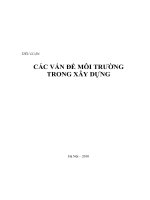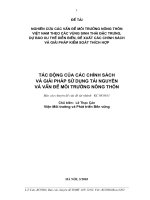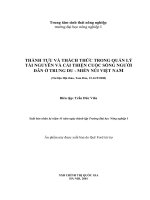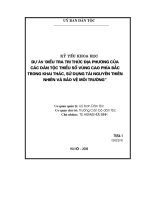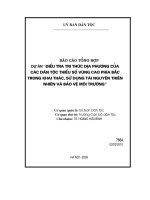Chapter III: Các vấn đề thách thức trong sử dụng tài nguyên thiên nhiên
Bạn đang xem bản rút gọn của tài liệu. Xem và tải ngay bản đầy đủ của tài liệu tại đây (592.95 KB, 35 trang )
CHAPTER III
CÁC VẤN ĐỀ THÁCH THỨC TRONG
SỬ DỤNG TÀI NGUYÊN THIÊN NHIÊN
1
TĂNG DÂN SỐ VÀ TÀI NGUYÊN THIÊN
NHIÊN
The global food demand scenario:
•
By 2050, the global population will be between 10 and 12 billion
as against nearly 6 billion of current population.
• These next 50 years will be critically important for sustainable
agriculture production. If food and fiber production are increased
by 2.5 to 3.0 times at acceptable costs, then achieving sustainability
will be a reality there onwards.
•Increase of intensive use of natural resources
•
Does population growth enhance or inhibit the
opportunities of a country’s natural resource
management?
•
Does the answer depend on the stage of
development?
•
In the recent period of population decline, what are
the possible effects of this decline on natural
resources management?
Population Growth
• Population growth and age structure makes a difference in economic growth
(output level depends on output per worker and the number of labor) and hence
in the condition of natural resources
• Population growth and its composition also affects the level of savings and
investment in natural resources
• The negative effect of population growth is the application of law of diminishing
marginal productivity.
- Technology have positive effect
- Economies of scale have positive effect
• Relatively high rate of population growth increases the degree of inequality and
elite capture of resources can take place.
• Income inequality results from the effect of population growth on the labor supply
Effects of economic growth on population growth
Stage 1
The period immediately prior to industrialization when the birth
rates are stable and slightly higher than death rates ensuring
population growth.
Stage 2
The period immediately following the initiation of industrialization,
when death rates fall dramatically with no accompanying change in
birth rates. The decline in mortality results in a marked increase in
life expectancy and a rise in the population growth rate.
Stage 3
The period of demographic transition when there will be large
decline in the birth rate which exceed the continued decline in the
death rate
Demographic Transition
Economic approach to population
control
• Benefit cost approach
B/C analysis of a population control compared if some government
control measure (investment) would maximize efficiency (benefits).
• Micro demographic theory of fertility
The demand for children will, as with more conventional
commodities, be downward sloping which means the more expensive
children become, the fewer will be demanded
Issues related to NRM
• Issues differ from place to place and with type of
resource.
• Issues can be grouped into:
– Environmental
– Social
– Economical
– Legal/institutional
8
Environmental issues: examples
• Deforestation
• Loss of biodiversity
• Soil erosion
• Loss of soil fertility
• Salinity/acidity
etc.
9
Economic issues: examples
• Sustained yield
• Equitable sharing of benefits
• Poverty reduction
• Employment
etc.
10
Các vấn đề pháp lý và thể chế
•
How much to decentralize?
Two school of thoughts :
– a complete and radical devolution of
resource management responsibility and
authority to local users
– co-management
11
Issues ….
Lack of consultative process involving all related actors
in policy making.
Lack of comprehensive and updated information on:
– the resource base,
– socioeconomic features
12
Issues ….
Lack of political will, support, and commitment.
Contradictory provisions in relevant Acts.
Differing values of the resource among stakeholders.
13
Social issues: examples
– Social exclusion
– Social acceptability
– Gender related issues
– Conflicts and controversies
………….
etc.
14
Social exclusion
“Situations where least privileged groups of the population
experience a combination of problems, undermining their
ability to fully participate in society and to access basic
social infrastructures” (Paraskevopoulos et al. 2003).
It is a multifaceted phenomenon with 3 principal
dimensions: economic, social, political.
15
Social acceptability
• Key influencing factors:
– Situational, spatial, and social context
– Institutional and individual trust
– Perceptions of risk
– Forms of knowledge
16
Research findings on social acceptability
– Natural resource agencies focus too much on
the social acceptability of their decisions as
opposed to the acceptability of their decisionmaking processes.
– NRM programs are dominated by the
technical-rational paradigm (which acts to
constrain incorporation of subjective,
qualitative knowledge).
– Our understanding of the social acceptability
of decision-making processes is incomplete
and needs further study.
17
Use conflict: an example
• Multiple uses of water: industrial (cleaning, washing,
power supply, heating etc.); commercial (transport,
processing etc); agricultural (irrigation, animal drinking
etc); recreational (fishing, swimming, boating); human
personal (drinking, washing, cleaning etc); wildlife
habitat/support (aquatic species, wetlands etc).
18
Urban and rural people view the natural environment differently:
An example of forest use conflict between urban and rural people
19
20
21
Conflicting values
• Gender-related issues – e.g. men and
women may have different concerns and
options with regard to the management of a
natural resource.
• The value of biodiversity can be different for
different groups within the society (local,
national/regional, global levels). Who are the
real beneficiaries of biodiversity
conservation? --- there is an ongoing debate.
22
A FRAME-WORK FOR THE STUDY OF NATURAL
RESOURCES CONFLICT MANAGEMENT
• Understanding conflicts
• Study of behaviors of the actors in conflicts related
natural resources
• Role of context, contents and time in conflict
• Conflict Management (CM) means, forums and
practices
• Consequences of conflicts to natural resources and
society
• Scope for improvement in CM through social
learning.
23
Understanding conflict
• Conflict is an active stage of disagreement between
people with opposing opinions, principles and practices
manifested in different forms (grievance, conflict and
dispute). (Walker and Daniels, 1997).
• According to the stages of transformation of conflict are:
(a) Naming, (b) Blaming, (c) Claiming and (d) Dispute.
24
Understanding conflict
• Conflicts can be categorized into four groups based on
its solvability: They are:
– A terminal conflict that seems unsolvable by
agreement and results in a win-lose situation.
– A paradoxical conflict which looks obscure
and of questionable solvability having a loselose outcome.
– A litigious conflict which seems solvable and
produces a win-win or a consensus result.
– An Illusory conflict where disputants want the
same thing but fail to realize it.
25


